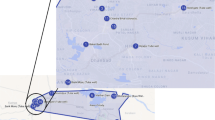Abstract
This study was carried out to assess the fluoride concentration in groundwater in some villages of northern Rajasthan, India, where groundwater is the main source of drinking water. Water samples collected form deep aquifer based hand-pumps were analysed for fluoride content. Fluoride in presently studied sites was recorded in the ranges of 4.78 and 1.01 mg/l. The average fluoride concentration for this region was recorded 2.82 mg/l. As per the desirable and maximum permissible limit for fluoride in drinking water, determined by WHO or by Bureau of Indian Standards, the groundwater of about 95 of the studied sites is unfit for drinking purposes. Due to the higher fluoride level in drinking water several cases of dental and skeletal fluorosis have appeared at alarming rate in this region. The middle and eastern parts of the Hanumangarh, a northern most district of the state, can be classified as higher risk area for fluorosis; due to relatively high concentrations of fluoride (3–4 mg/l) in groundwater of this region. After evaluating the data of this study it is concluded that there is an instant need to take ameliorative steps in this region to prevent the population from fluorosis.
Similar content being viewed by others
References
Brouwer, I. D., De Bruin, A., Dirks, O. A., & Hautvast, J. (1988). Unsuitability of WHO guidelines for fluoride concentration in drinking water in Senegal. Lancet, I, 223–225.
Bureau of Indian Standard (BIS) (1991). Indian standard specification for drinking water. IS, 10500, pp. 2–4.
Ekstrand, J. (1996). Fluoride metabolism. In O. Fejerskov, J. Ekstrand, & B. A. Burt (Eds.) Fluoride in dentistry (pp. 55–68). Copenhagen: Munksgaard.
Froda, A. S. Joshi, D. C., & Ram, B. (1999). Agroecological zone of north-western hot arid region of India (pp 24). CAZRI India.
Kaushik, A., Kumar, K., Sharma, I. S., & Sharma, H. R. (2002). Groundwater quality assessment in different landuse areas of Rohtak and Fridabad cities of Haryana using deviation index. Journal of Environmental Biology, 25, 173–180.
Khaiwal, R., & Garg, V. K. (2006). Distribution of fluoride in groundwater and its suitability assessment for drinking purposes. International Journal of Environmental Health & Research, 16, 166–169.
Khaiwal, R., & Garg, V. K. (2007). Hydro-chemical survey of groundwater of Hisar city and assessment of defluoridation methods used in India. Environmental Monitoring & Assessment 132(1–3), 33–43.
Kumaran, P., Bhargava, G. N., & Bhakuni, T. S. (1971). Fluorides in groundwater and endemic fluorosis in Rajasthan. Indian Journal of Environmental Health, 13, 316–324.
Singh, B., Gaur, S., & Garg, V. K. (2007). Fluoride in drinking water and human urine in southern Haryan, India. Journal of Hazardous Material, 144(1–2), 147–151.
Steinberg, C. L., Gardner, D. E., Smith, F. A., & Hofge, H. C. (1955). Comparison of rheumatoid (ankylosing) spondilitis and crippling fluorosis. Annals of Rheum Disease, 14, 378–384.
Teotia, S. P. S., Teotia, M., Singh, D. P., Rathour, R. S., Singh, C. V., & Tomar, N. P. S., et al. (1984). Endemic fluorosis: Changes to deeper bore wells as a practical community-acceptable approach to its eradication. Fluoride, 17, 48–52.
UNICEF (1999). States of the Art Report on the Extent of Fluoride in Drinking Water and the Resulting Endemicity in India. Report by Fluorosis and Rural Development Foundation for UNICEF, New Delhi.
USPHS (United States Public Health Service) (1962). Drinking Water Standards. USPHS, Publications 956, USGPO, Washington DC.
WHO (World Health Organization), (1997). Guideline for Drinking Water Quality Health Criteria and Other Supporting Information, vol. 2, 2nd ed. Geneva.
WHO (World Health Organization) (2006). Fluoride in drinking water p. 144. London, UK: IWA publishing.
Whitford, G. M. (1997). Determinants and mechanisms of enamel fluorosis. Ciba Foundation Symposium, 205, 226–241.
Whitford, G. M., Pashley, D. H., & Stringer, G. I. (1976). Fluoride renal clearance: A 334 pH-dependent event. American Journal of Physiology, 230, 527–532.
Wood, J. M. (1974). Biological cycles for toxic elements in the environment. Science, 183, 1049–1052.
Author information
Authors and Affiliations
Corresponding author
Rights and permissions
About this article
Cite this article
Suthar, S., Garg, V.K., Jangir, S. et al. Fluoride contamination in drinking water in rural habitations of Northern Rajasthan, India. Environ Monit Assess 145, 1–6 (2008). https://doi.org/10.1007/s10661-007-0011-x
Received:
Accepted:
Published:
Issue Date:
DOI: https://doi.org/10.1007/s10661-007-0011-x




